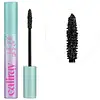What's inside
What's inside
 Key Ingredients
Key Ingredients

 Benefits
Benefits

 Concerns
Concerns

 Ingredients Side-by-side
Ingredients Side-by-side

Water
Skin ConditioningAcrylates Copolymer
Stearic Acid
CleansingPropylene Glycol
HumectantCopernicia Cerifera Wax
Cera Microcristallina
Emulsion StabilisingSilica
AbrasivePolyethylene
AbrasiveTriethanolamine
BufferingDecyl Glucoside
CleansingCetearyl Alcohol
EmollientVp/Eicosene Copolymer
Glyceryl Stearate
EmollientPEG-100 Stearate
Phenoxyethanol
PreservativeCaprylyl Glycol
EmollientEthylhexylglycerin
Skin ConditioningCI 77266
Cosmetic ColorantWater, Acrylates Copolymer, Stearic Acid, Propylene Glycol, Copernicia Cerifera Wax, Cera Microcristallina, Silica, Polyethylene, Triethanolamine, Decyl Glucoside, Cetearyl Alcohol, Vp/Eicosene Copolymer, Glyceryl Stearate, PEG-100 Stearate, Phenoxyethanol, Caprylyl Glycol, Ethylhexylglycerin, CI 77266
Water
Skin ConditioningStyrene/Acrylates Copolymer
Glyceryl Stearate
EmollientCopernicia Cerifera Wax
Microcrystalline Wax
Emulsion StabilisingCetearyl Alcohol
EmollientAcrylates Copolymer
Argania Spinosa Kernel Oil
EmollientPropanediol
SolventSynthetic Wax
AbrasiveTocopherol
AntioxidantCeteth-10 Phosphate
CleansingDicetyl Phosphate
EmulsifyingHydroxyacetophenone
AntioxidantHydroxyethylcellulose
Emulsion StabilisingSodium Citrate
BufferingSodium Hydroxide
BufferingPhenoxyethanol
PreservativeCaprylyl Glycol
EmollientEthylhexylglycerin
Skin ConditioningCI 77499
Cosmetic ColorantWater, Styrene/Acrylates Copolymer, Glyceryl Stearate, Copernicia Cerifera Wax, Microcrystalline Wax, Cetearyl Alcohol, Acrylates Copolymer, Argania Spinosa Kernel Oil, Propanediol, Synthetic Wax, Tocopherol, Ceteth-10 Phosphate, Dicetyl Phosphate, Hydroxyacetophenone, Hydroxyethylcellulose, Sodium Citrate, Sodium Hydroxide, Phenoxyethanol, Caprylyl Glycol, Ethylhexylglycerin, CI 77499
 Reviews
Reviews

Ingredients Explained
These ingredients are found in both products.
Ingredients higher up in an ingredient list are typically present in a larger amount.
Acrylates Copolymer is used as a film-forming agent and texture enhancer.
After applied, Acrylates Copolymer forms a thin film cover that helps skin feel more soft. It can help sunscreens become more water-resistant.
It is also used to make a product more thick.
Learn more about Acrylates CopolymerCaprylyl Glycol is a humectant and emollient, meaning it attracts and preserves moisture.
It is a common ingredient in many products, especially those designed to hydrate skin. The primary benefits are retaining moisture, skin softening, and promoting a healthy skin barrier.
Though Caprylyl Glycol is an alcohol derived from fatty acids, it is not the kind that can dry out skin.
This ingredient is also used as a preservative to extend the life of products. It has slight antimicrobial properties.
Learn more about Caprylyl GlycolCetearyl alcohol is a mixture of two fatty alcohols: cetyl alcohol and stearyl alcohol. It is mainly used as an emulsifier. Emulsifiers help prevent the separation of oils and products. Due to its composition, it can also be used to thicken a product or help create foam.
Cetearyl alcohol is an emollient. Emollients help soothe and hydrate the skin by trapping moisture.
Studies show Cetearyl alcohol is non-toxic and non-irritating. The FDA allows products labeled "alcohol-free" to have fatty alcohols.
This ingredient is usually derived from plant oils such as palm, vegetable, or coconut oils. There is debate on whether this ingredient will cause acne.
Due to the fatty acid base, this ingredient may not be Malassezia folliculitis safe.
Learn more about Cetearyl AlcoholCopernicia Cerifera Wax comes from a palm tree native to Brazil; another name for this ingredient is Carnauba Wax.
This ingredient is used to thicken texture and also leaves behind a film when applied.
Fun fact: This wax has the highest melting point of all natural waxes and low solubility.
Learn more about Copernicia Cerifera WaxEthylhexylglycerin (we can't pronounce this either) is commonly used as a preservative and skin softener. It is derived from glyceryl.
You might see Ethylhexylglycerin often paired with other preservatives such as phenoxyethanol. Ethylhexylglycerin has been found to increase the effectiveness of these other preservatives.
Glyceryl Stearate is a mix of glycerin and stearic acid.
It is used to stabilize the mixing of water and oil ingredients. By preventing these ingredients from separating, it can help elongate shelf life. It can also help thicken the product's texture.
As an emollient, it helps soften skin and supports barrier-replenishing ingredients.
In cosmetics, Glyceryl Stearate is often made from vegetable oils or synthetically produced.
This ingredient may not be fungal-acne safe
Fun fact: The human body also creates Glyceryl Stearate naturally.
Learn more about Glyceryl StearatePhenoxyethanol is a preservative that has germicide, antimicrobial, and aromatic properties. Studies show that phenoxyethanol can prevent microbial growth. By itself, it has a scent that is similar to that of a rose.
It's often used in formulations along with Caprylyl Glycol to preserve the shelf life of products.
Water. It's the most common cosmetic ingredient of all. You'll usually see it at the top of ingredient lists, meaning that it makes up the largest part of the product.
So why is it so popular? Water most often acts as a solvent - this means that it helps dissolve other ingredients into the formulation.
You'll also recognize water as that liquid we all need to stay alive. If you see this, drink a glass of water. Stay hydrated!
Learn more about Water